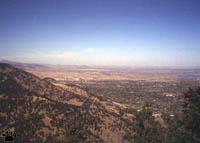
View of Boulder and the Great Plains from the Rocky Mountains.
Part 2 - Other rodents
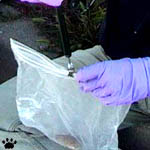
Weighing a mouse, Boulder.
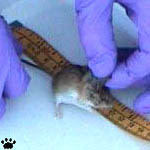
Measuring a mouse, Boulder. |
One of the main goals of the project is to understand
the role of other rodent species in the circulation of plague in nature. It is
believed that prairie dogs are too susceptible to this disease to be its main
hosts: infected colonies are usually wiped out within a few days. The theory we
were trying to confirm is that plague mostly circulates in other rodents, and
only occasionally jumps to prairie dogs. So we put thousands of man-hours in trapping
small rodents inside and outside prairie dog towns, and subjected them to the
same procedures as prairie dogs, except for microchipping. We shaved a little
spot on each mouse's rear end to avoid processing the same animal twice. |
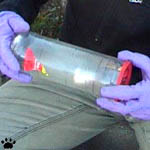
Anaesthesizing a mouse, Boulder.
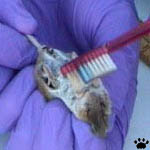
Brushing out fleas, Boulder. |
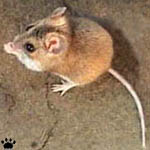

Deer mice have two color phases. In
Colorado and Kansas we mostly
captured chestnut adults (above,
Boulder), while in areas further north
some were gray (below, Wind Cave). |
The most common species of small rodent
on almost all research sites, and often the only species present, was deer mouse
(Peromyscus maniculatus). It is the most widespread small mammal in North
America, occurring from Arctic tundra and Alpine meadows to dry deserts and tropical
forests. No other continent has such an ubiquitous rodent. After handling many
hundreds of deer mice, I have a lot of respect for these tiny creatures - cute,
brave, and sometimes surprisingly smart. Their life is difficult. They can live
for up to 3 years, but the average lifespan is probably less than two months.
In addition to being a favorite prey of almost all carnivores, they suffer from
horrible diseases and parasites. And still they manage to succeed, and usually
look pretty happy. |
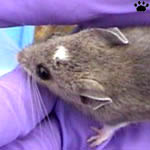
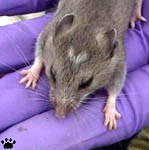
Juveniles of both phases are gray
These two babies were captured
at the same site. Judging by their
unusual markings, they were almost
certainly brothers. Boulder. |
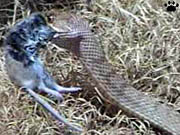 |
Watching these charming animals suffer so much
makes you bitterly feel the stupidity of the idea of a kind and loving God. Only
a sadistic maniac could intentionally create such a cruel world. |
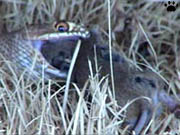 |
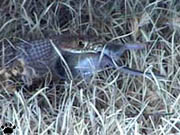 |
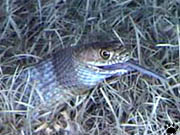 |
 |
| It took this racer(Coluber constrictor)
just two minutes to swallow a deer mouse. Comanche Nat'l Grassland. |
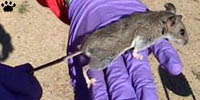
Rock mouse(Peromyscus nasutus), Boulder. |
Other Peromyscus species are more specialized.
They don't occur in prairie habitats, so we virtually never caught them in our
traps. |

Rock mouse(Peromyscus nasutus), Boulder. |
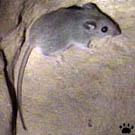 |
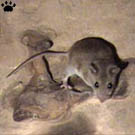 |
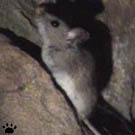 |
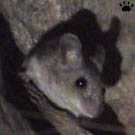 |
| Brush mice(Peromyscus boylii),
Painted Canyon, Colorado. |
Pinyon mouse(Peromyscus truei),
Painted Canyon, Colorado. |
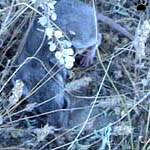
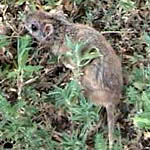
In the northern part of their range,
Northern grasshopper mice are
smaller, and are more often gray
than brown (above, Thunder Basin).
In the south, they are mostly brown
and very large (below, Cimarron). |
In most places except for Boulder
area, the second most common species of small rodent was Northern grasshopper
mouse (Onychomys leucogaster). It was of particular interest for us, because
it is a predator, feeding mostly on large insects and small mammals, including
its close relative the deer mouse. While chasing their prey in burrows and nests,
grasshopper mice probably pick up a lot of fleas from many places. They are suspected
to play an important role in disease circulation in Nature. This genus is also
known for some interesting behavior, including its scorpion-catching techniques
and wolf-like territorial howls - piercing high-pitch squeaks that can be heard
half a mile away on quiet nights. Trapping them alive requires a lot of care,
because they are more sensitive to overheating than deer mice. |

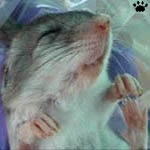
Just as in deer mice, juveniles of
both color phases are mostly gray
Despite their fearsome reputation,
grasshopper mice are easy to handle,
and can be very cute.
Cimarron Nat'l Grassland, Kansas. |
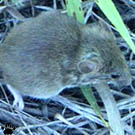
Western harvest mouse is smaller
than deer mouse, has yellowish
patches behind ears and longer
tail. Boulder. |
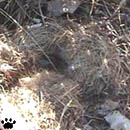
Harvest mice live in ball-shaped
nests made of grasses and built in
dense grass. This one was under
a piece of plywood. Boulder. |
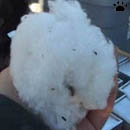
This nest was built of cotton
inside one of our traps. Deer mice
also make nests, but mostly in
cold weather or for breeding. |

Harvest mice would often remain
in the nest even when it's handled.
They are generally very tame, and
a pleasure to work with. Boulder. |
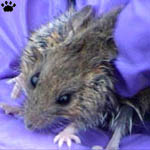
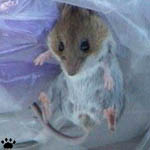
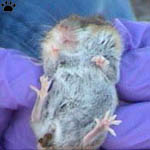
Tiny and calm, harvest mice are very
easy to handle. Boulder. |
In Boulder area, the second most common
species was Western harvest mouse (Reithrodontomys megalotis). This species
seems to be innocent of plague transmission. It prefers tall dense grass, so it
virtually never occurs on prairie dog towns. Besides, harvest mice in our area
seem to have very few, if any, fleas. One possible explanation is that they live
solitary lives in self-constructed grass nests. Deer mice and most other prairie
rodents use burrows (often prairie dog burrows), where flea larvae can live, and
fleas can move from one host to another.
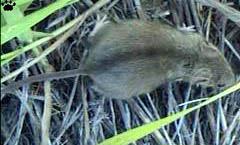
Plains harvest mouse (R. montanus) also occurs throughout
most of the prairie, but for some reason we never captured any.
Black Kettle Nat'l Grassland, Oklahoma. |
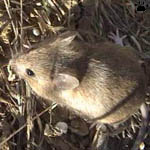
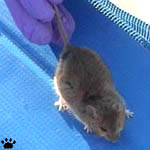

Harvest mice look lean, unless
pregnant. Boulder. |
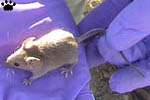 |
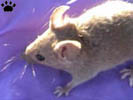 |
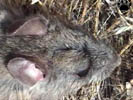 |
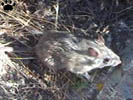 |
| House mouse (Mus musculus),
Boulder. |
Mexican woodrat (Neotoma mexicana),
Boulder. |
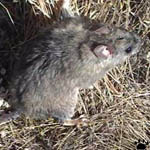
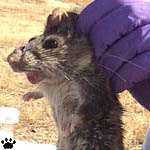
Mexican woodrat lives in foothill
woodlands, shrubs, rock piles,
talus slopes, houses, and pine
forests. Lyons, Colorado. |
Many prairie rodents can live in human
houses: deer and sometimes harvest mice, voles, even ground squirrels. Woodrats
and particularly house mice are more common around towns than in remote areas.
(Words mouse and rat don't have much biological meaning. Woodrats
are related to deer, harvest, and grasshopper mice, while house mouse is an introduced
Eurasian species relative to Norway and roof rats of genus Rattus. The
only difference between mice and rats is in size.) One of the goals of the project
is to study differences in rodent distribution and disease circulation between
highly fragmented suburban habitats and relatively pristine prairies. |
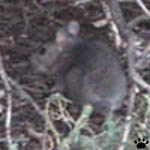

Southern Plains woodrat (N.
micropus) lives in prairie bushes (above) and abandoned farmhouses
(below). Comanche Nat'l Grassland. |
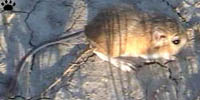 |
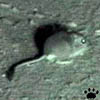 |
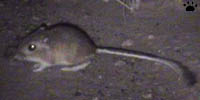 |
| Ord's kangaroo rats(Dipodomys
ordii), Thunder Basin. |
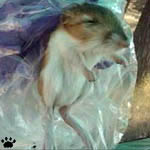
Ord's kangaroo rat, Wind Cave.
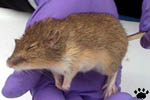
Hispid pocket mouse, Boulder. |
Some species were more difficult to
trap than others. Ord's kangaroo rat was abundant in most places. While spotlighting,
I saw hundreds per hour on some nights in Thunder Basin, Comanche and Cimarron
National Grasslands, and a few in Boulder area. But we captured relatively few
of them, and none around Boulder. Hispid pocket mouse (Chaetodipus hispidus)
seemed almost absent from Boulder area in June, but became the second most common
species is September. I think it became more willing to enter traps because the
grass had dried out and there was less natural food available. |
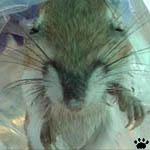
Ord's kangaroo rat, Wind Cave.
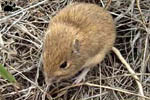
Hispid pocket mouse, Boulder. |
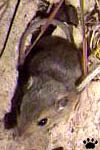 |
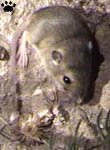 |
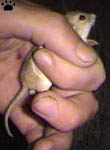 |
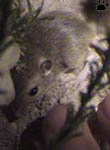 |
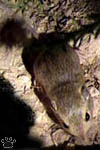 |
| Silky pocket mice, Cimarron Nat'l
Grassland. |
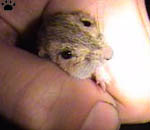
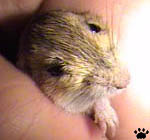
Silky pocket mouse is only 10-12 cm
(4-4 3/4") long, half of it tail.
Comanche Nat'l Grassland. |
My favorite grassland rodents are
Perognathus pocket mice. We captured only two this season, but I saw a
lot of them while spotlighting. They are so tame that sometimes you can pet and
hand-feed them. Plains (P. flavescens) and olive-backed (P. fasciatus)
pocket mice live in sandy prairies, while silky pocket mouse (P. flavus)
prefers rocky areas. The latter is the smallest (6-9 g) and the cutest of them.
It lives in burrows less than 5 inches deep, sometimes in anthills. Pocket mice
are relatives of kangaroo rats - they are also very agile and can leap well. |
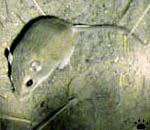
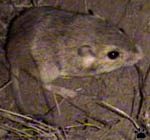
Olive-backed (above, Thunder Basin)
and Plains (below, Pawnee Nat'l
Grassland) pocket mice. |
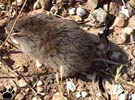 |
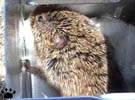 |
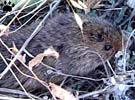 |
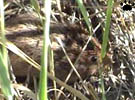 |
Meadow vole (Microtus
pennsylvanicus), Thunder Basin. |
Montane voles (M. montanus),
Lyons. |
Prairie vole (M. ochrogaster),
Boulder. |
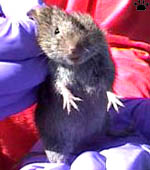
Meadow vole, Boulder. |
Unlike most mice, voles feed on grass rather than
seeds. They are also less agile, and don't wander far from their burrows. For
these reasons they prefer places with lush dense vegetation. Most of our research
sites were in dry shortgrass areas, so we caught only a few voles. It took us
a long time to sort out the three very similar Microtus species of our
area. |
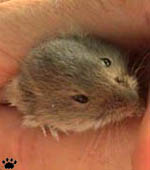
Baby meadow vole, Thunder Basin. |
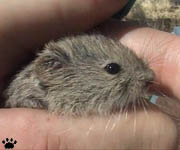
Baby sagebrush vole, Thunder Basin Nat'l
Grassland. |
Our most surprising find so far was a capture
of two sagebrush voles (Lemmiscus curtatus) in Thunder Basin, Wyoming.
This species is common and widespread in intermontane deserts further west, but
it has never been recorded in that part of the Great Plains before. |
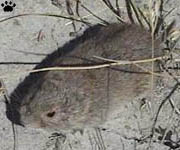
Like their closest relatives, steppe lemmings
of Asia, sagebrush voles are very tame. |
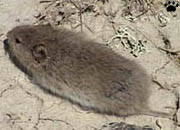 |
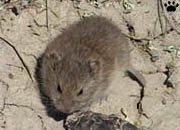 |
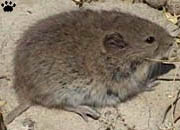 |
| Sagebrush vole, Thunder Basin. |
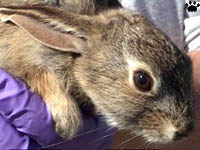
Baby desert cottontail rabbit
(Sylvilagus audubonae), Boulder. |
The possibility of catching something new and
unexpected was one of the exciting parts of the work. Plus spending summer in
great places, getting hands-on knowledge of the prairie, and meeting so many nice
characters, human and rodentian. |
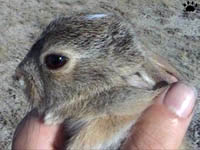
Baby white-tailed jackrabbit
(Lepus townsendii), Thunder Basin. |
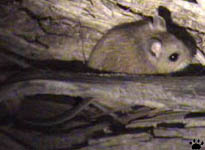 |
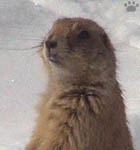 |
 |
| In winter, grassland rodents have
thick fur. Left - deer mouse, Thunder Basin; center and right - black-tailed prairie
dogs, Boulder. |
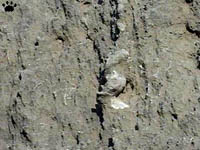
Fossilized corcscrew-shaped burrows,
Agate Fossil Beds Nat'l Monument, Nebraska. |
Large burrow-building rodents have been part of
grassland environment for at least 50 million years. Now the temperate grassland
is one of the planet's most endangered ecosystems. It's up to us to make sure
it survives with all its inhabitants. |
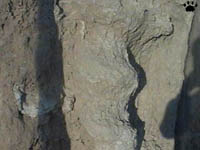
These burrows were built 25 million years ago
by Paleocastor, now-extinct terrestrial beaver. |
Home
|
|